Recently a cybernet note suggested that someone had a good understanding of the taxon/species, H. intermedia v.Poelln. That same writer has been a bit casual in describing new varieties, and in explaining what he actually means when he has used the species epithet accompanying them. Understanding is a very relative term. It may be extraordinary in terms of people who do not deal in the subject at all, high in relation to the knowledge level of the people with whom one is in ordinary contact and it may be very low in relation to people deeply involved in the subject. It may also be quite negligible in terms of truth and ultimate reality. With this in mind, I am going to take an opportunity to explain my own use/misuse of the epithet “intermedia”, and change it. For several years I have been plagued by articles and statements in Haworthiad (and elsewhere), which are not strictly true. In fact this distress goes back to correspondence with, and publications by, Col. C.L. Scott starting in 1965. So when Dr Urs Eggli recently kindly stated to me his approach as follows:
….”Classification (systematics) for me has always been an ATTEMPT to understand how biological diversity could have arisen. In contrast to mathematics and physics, biology is not what we in German term “exact science”, since we cannot prove anything except what we currently see (presence or absence). Any question which starts with “why” defies proofs. It may have one and only one correct answer, but in my opinion, we have no way to decide which of several possible answers is the only correct one. Accordingly, I never place much weight on a classification, be it mine or that of somebody else. I approach the problem from a more practical side: ‘Does the classification help me to get some understanding of the observed diversity and variation, and does it appear plausible.'”
His comment exposed for me the very roots of my discontent and unrest concerning the approach of the succulent enthusiast, and his community, to classification in general and of Haworthia in particular. Also stirring my curiosity about the way the “scientific community” seems to regard my publications on Haworthia. In fact Dr. Eggli is saying that in not knowing Haworthia himself, he is required to adopt a practical approach. My curiosity regarding this subject is always aroused in informal contact with biologists, with ecologists and with taxonomists, and also with writers who have reviewed and commented on my publications. It is also piqued by the responses I receive from editors in my communication with them about publications as well as about my own manuscripts. So I replied to Dr. Eggli as follows:
….”I would like your help in unravelling this issue of classification. Haworthia has been wracked with problems since von Poellnitz, Smith, Brown, and Uitewaal. It is not a different problem to that in other groups ‑ it is just that Haworthia is more visible in the way that it is collected and grown, and in the number of people who try to write about them? Plausibility has always been a problem and I have never understood my colleagues at the Compton, Bolus and PRE herbaria who have this common laissez faire attitude to classification. None of them could speak to me about the problem I had with Col. Scott’s classification. Even now, my classification is ignored by them because they cannot actually determine plausibility of my “opinions” against Scott’s. I have written extensively about the question of plausibility using other words for it, but no one seems to take the issue seriously. Reviews of my revision by botanists have been fatuous and all they can seem to really contribute is pseudo‑intellectual comments on the nomenclature and the requirements of the code. In my address to Succulenta 2000 (Congress held at Kirstenbosch) I pointed out the absence of a definition of the “species”. Actually it is a fundamental problem which comes down to Darwinism and science and elementals ‑ which is what my review (see later chapter) of Gould’s book (Rock of Ages, Jonathan Cape, 2001) is about.
“If you have seen my analysis of Prof. Vosa’s cytological work on Gasteria, you will see the style of botanical science which I experience regularly. Yet there is this same laissez faire attitude because the average botanist does not actually know what is being written about regarding subjects which are not in their specific field of work even although they may impact on what they write. What actually happens down at the lower ranks (where I labour), is that we have a huge group of uninformed readers who get the kind of leadership which botanists in forewords to Breuer’s two books World of Haworthias Vols 1 & 2 provide. Thus an environment is brewed which makes it extremely difficult to achieve credibility and to know what is plausible and what is not, and to whom. Breuer also gets credibility for a publication in Taxon which is a chronological mishap, where he has done typifications without really knowing what the names were for, or knowing what names are going to be needed. Nor has he persuaded me that he has really understood what has already been written.
“All this may have been manageable 40 years ago ‑ but we cannot go on with all these meaningless changes of name, or creation of new names, based on weak opinion and the absence of sound or reasonable peer review. Our botanical leadership is just non‑existent, and it frustrates me no end to find myself trying to play this role against the tide of people who should be doing it. To say you have not followed my review of Gould’s book is something of an apology, but you should know what Gould and Linde say in the (Scientific America Book of the Cosmos, MacMillan, 2000).
“Where I would like some help is on this issue of “how?” as opposed to “why?”. Newton surely asked ‘Why did that apple fall?’ ALL questions have answers and are thus valid when one seeks to know. Science seeks to know. Science does not belong to physicists or botanists. And what physicists know, botanists must know, even if it is only in general terms. How are we going to make progress unless botanists, and those posturing as botanists, as a whole think at the level of scientists in other disciplines? Botany and biology appear to me to be in a dark age of a new religion of “science”. This is what Linde is hinting at in “Book of the Cosmos”.
“My recent work on Haworthia confirms what I said long ago. I just put it now in other words. Species are fractal. Darwinism is a partial answer. Species vary and change “chaotically”, and there may well be (is, is my honest view) purpose and meaning. Botanists seem to happily go along with the old view that reductionism will produce answers, when in the hard sciences it has been fairly well proven that it will not. Where do biologists stand on this issue? They do not seem to want to know?”
That was my letter.
A point I now make, is that the question “how biological diversity could have arisen”, might be validly and better answered by the question …”why is it like this?” Another question is this about the philosophy of science itself…”Can any hypothesis be proven?” In statistics, the null-hypothsis is chosen on the basis that you can never prove a hypothesis but you can disprove it.
Without repeating any of my arguments I placed before Succulenta Congress 2000, I want to say that writers are claiming an understanding of taxa when in fact they do not actually know what the significance of any taxon may be. I wrote in Haworthia Revisited (1999) … “The basis of classification of Haworthia must be the geographical component.” The tendency in both the professional and academic ranks is still to recognise “species” on the flimsiest of morphological pretences, and to rank nomenclature wholly disproportionately to the function of identification and communication. This is never going to help to resolve a problem which is falsely seen to exist uniquely in Haworthia. This is a complete misconception.
The case of H. intermedia may help to clarify a few points that I have made.
In writing Haworthia Revisited, I adopted an even more concise style than usual. In the case of H. intermedia, I knowingly strayed, but I did not quite appreciate that my disrespect for the cosmetics of nomenclature would lead me to deliberately obstruct its objective. I in fact needed a name for an element I collected in KG106/70 (later recollected as MBB6514), from a site, Buitenstekloof between Robertson and Worcester.
What actually happened is this, von Poellnitz described H. intermedia in Kakteenkunde 1937 p.134, citing “Cape, Robertson, McGregor: Mr. G.J. Payne sn. (coll. Triebner 956)”. There was no accompanying illustration. He used the epithet “intermedia” because he felt that the plant (probably a single plant) was intermediate between H. integra (which, with all the confusion associated with that epithet, can perhaps safely be assigned to H. mucronata – i.e. safely for anyone with actual understanding of the uncertainty of Haworthia) and with H. haageana and its var. subreticulata (both v.Poelln.).
Let us just examine this. H. haageana, based on the photograph in Berlin (of which I saw a copy in 1969), chosen by Breuer as lectotype too, is safely ascribable to H. reticulata despite being said to be from Grahamstown. The variety subreticulata, also said to have come from Grahamstown, is arguably ascribable to H. reticulata judging from the available photograph. It could actually be something else.
When I met George Payne in 1970, I specifically asked him about H. intermedia and he informed me that he had collected it at Buitenstekloof. That is where I found H. reticulata (KG105/70) and which is why intermedia appears in my earlier publications as a synonym of H. reticulata (see Fig.1). This Fig.1 is an unpublished picture recently dredged out of the Berlin Herbarium as the type of H. intermedia, and I think it can be taken to confirm this first diagnosis. This is despite the comment by von Poellnitz that the leaves were “marked differently”! Some troubles appear when it is shown that von Poellnitz added a reference to a plant collected by Eric King at Scottburgh Farm (in Long474, Port Elizabeth, to his 1938 Feddes Repert. citation of H. intermedia (Fig.2, also an unpublished herbarium illustration). This plant could be one of those dubious things common in that area (particularly Hankey/Patensie/Humansdorp) which is neither H. cooperi(gracilis) var. picturata nor H. cooperi var. gordoniana. It is not possible for geographical reasons to suggest that the Buitenstekloof and the Port Elizabeth plants can be synonymous. When I came to write Haworthia Revisited, I was frankly just frustrated and irritated with the silly requirements of nomenclature and need for the frivolity of a latin synopsis. I had this second element from Buitenstekloof (and I am not talking about a single plant) which was not H. reticulata, and I doubted that Payne had ventured to where I found it (Fig.3 MBB6514). Unlike the reticulata there which is on the dolomite, this element is on shale. It may be neither H. maraisii var. notabilis (in that element’s many guises), and nor is it H. maculata which has its own problems. So I lifted the name intermedia and used it here in relating the plant to H. maculata. I really did not think this would ultimately give any sensible revisioner who really bothered to explore that mountaineous and geologically complex terrain for better answers, any serious problems. In fact my intention was that my treatment would demand a thorough exploration of the area. As it is, I know of three unconfirmed collections which need to be followed up if any more acceptable answer is going to be obtained. I really did not think that buffoonery of a greater order than my own was going to prevail, but so it has. Figs 1, 2 & 3 are from World of Haworthia, Vol.2 pp529-30, by I. Breuer. Here in juxtaposing the illustration of what could be three quite different species, Breuer is suggesting that these are all intermedia.
A plant illustrated by Breuer as H. maculata var. intermedia (Fig.3) is from my collection MBB6514, and it is correct for my use of the epithet. But it is not necessarily H. intermedia of von Poellnitz, and seeing Fig.1 for the first time I would have stayed with my conviction that this could have been H. reticulata. So, while explaining again that von Poellnitz was dithering between reticulata, mucronata and “gracilis”, that J.R. Brown was doing the same at Sectional level, that Breuer implies that they are all the same, and that Bayer has a different opinion; it is quite obvious that someone else now claiming understanding of this taxon, is making a very wild statement. To correct the situation and preclude a minor disaster, I correct the deliberate and regrettable misuse of an epithet as follows:
Haworthia maraisi var. notabilis (v.Poelln.) Bayer
syn. Haworthia maculata var. intermedia Bayer in Haworthia Revisited 1999 p.91, non v.Poelln. in Kakteenkunde 137, 1937. An incorrect name under Art. 11.4 of the code, because of the principle of priority (with gratitude to Dr Urs Eggli).
H. reticulata Haw.
syn. Haworthia intermedia v.Poelln. in Kakteenkunde 137, 1937. Lectotype: Breuer et al Cape, McGregor, Robertson, G.J. Payne (Triebn.956), B.
Thus my use of the epithet intermedia was for a population-based variant possibly of …
1. H. maculata, despite having a later flowering time. This is quite extensively discussed in Haworthia Revisited. H. maculata is recognised as it occurs in a series of closely spaced populations north of the Brandvlei Dam at Worcester, and as two populations approximately at Sandhills, north-east of Worcester.
2. H. maraisii var. notabilis, despite having a flower more typical of H. maculata. This variety is recognised in the population at Buitenstekloof discussed above, a population north of Agtervink west of Robertson, three closely spaced and variable populations at Wolfkloof, Robertson (the type locality for H. notabilis v.Poelln.) this variety, and three populations in the Klaasvoogds Valley east of Robertson (Figs.4 to 9 and map Fig.10). Note that the plants illustrated are individual clones only and do not convey the variability of the respective populations. The flowering times of the populations other than Buitenstekloof one (Nov.) is approximately Sept. but the Kranskop population had flowering specimens as early as May. H. maraisii mostly flowers early winter viz. late March to May.
I have now chosen the latter option because it does not require any nomenclatural manipulation. It should be quite evident by now that a species concept for Haworthia (actually any species) has to consider that the species is a complex system of individuals that vary with place and time. Should anyone be misguided enough to claim any knowledge of von Poellnitz’s H. intermedia, they must please go further than my attempt to do so either here or in my revision. They must also competently demonstrate that they have read and understood at least this explanation.
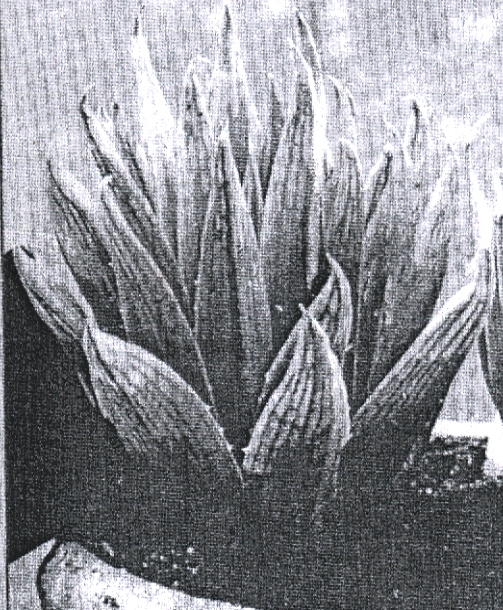

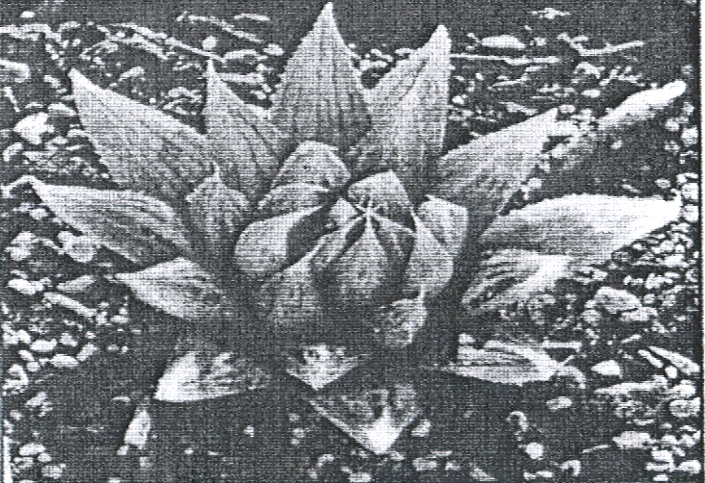




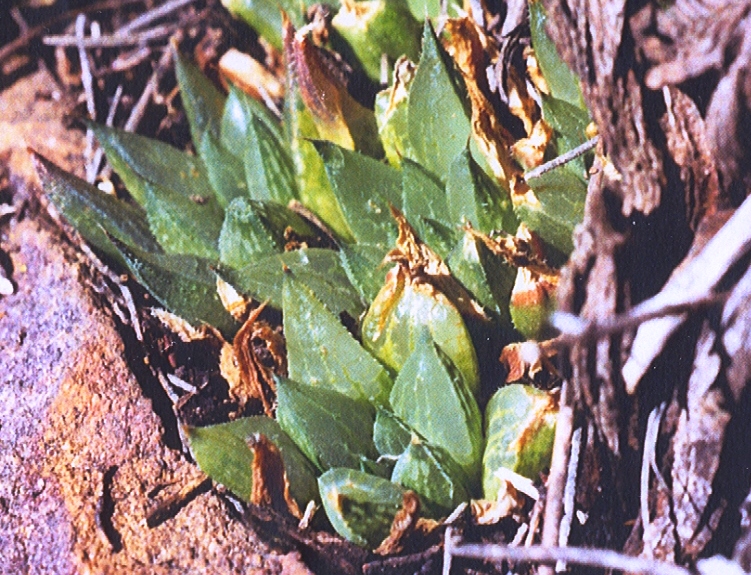
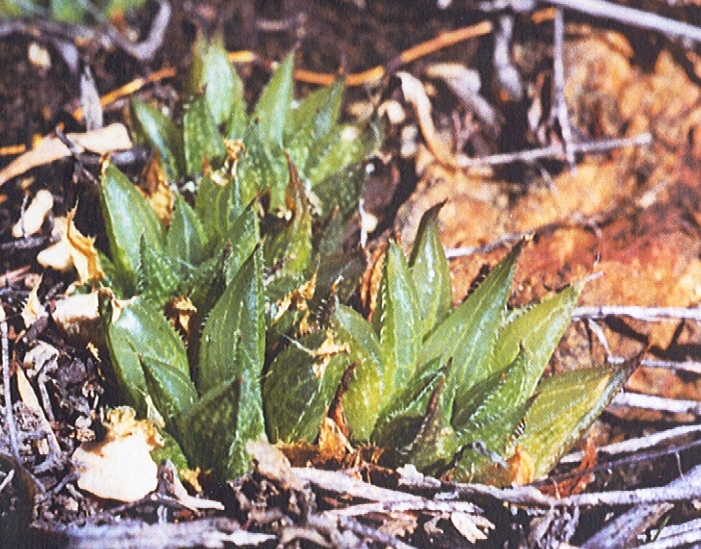

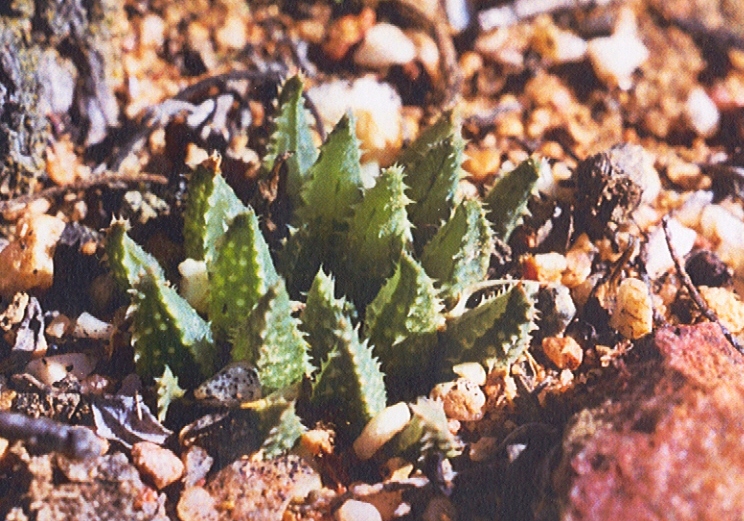

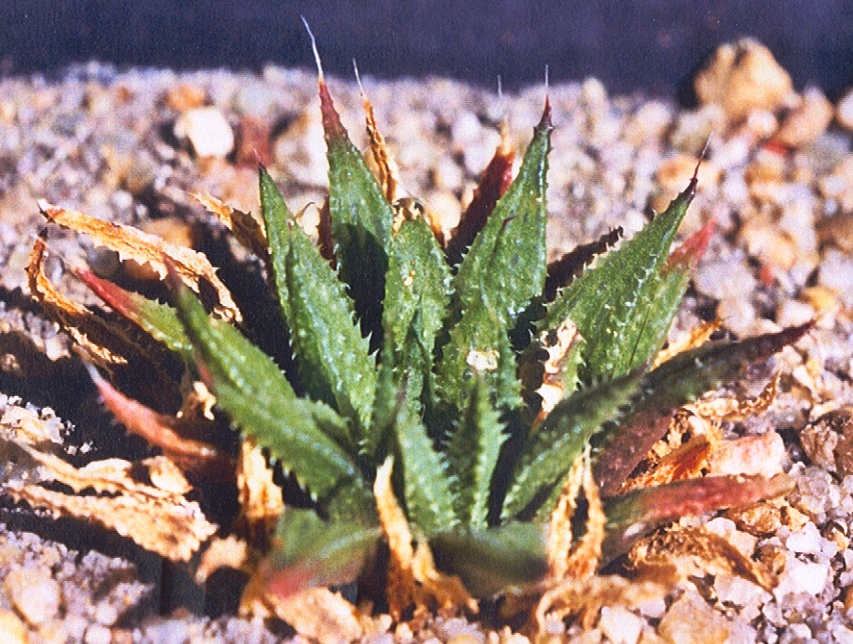
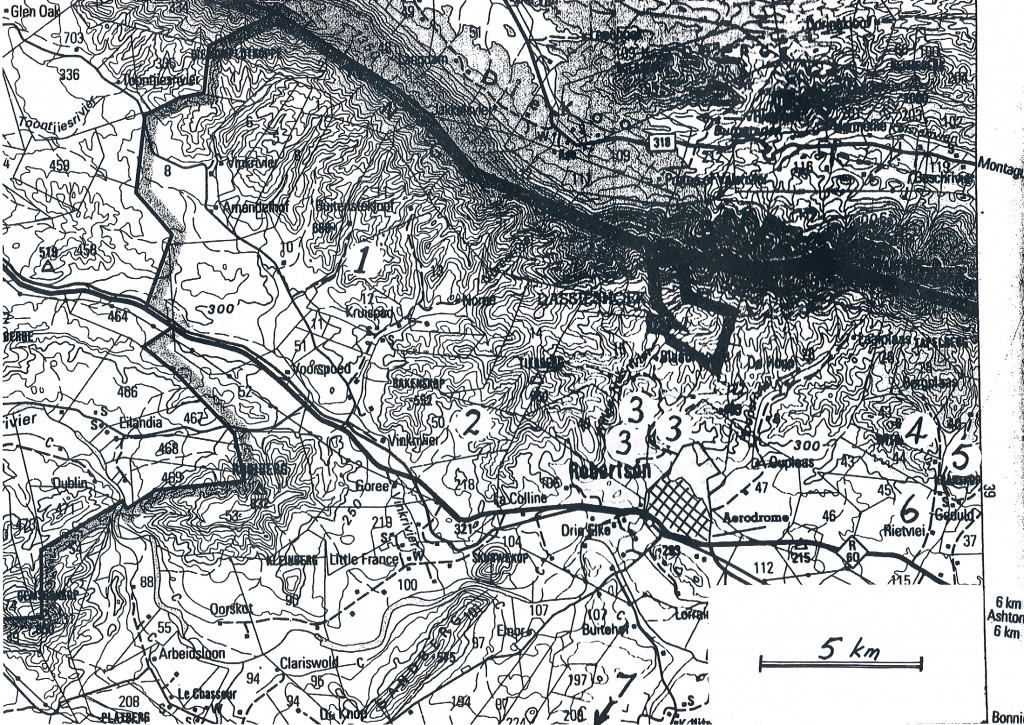
References
- Bayer, M.B. Haworthia Revisited, Umdaus 1999.
- Bayer, M.B. Natural Variation and Species Delimitation in Haworthia Duv. Pt.1. H. reticulata Haw. Nat.C.S.Jl.27:10(1972).
- Breuer, I. The World of Haworthia Vol.2, Breuer & Arb. Mamm. 2000.
Key to illustrations
Fig.1. Triebner 956 H. intermedia V.Poelln. as illustrated in Breuer, World of Haworthia, Vol.2:529 = H. reticulata.
Fig.2. Long 474 “H.intermedia” ex Scottburgh, Port Elizabeth (Breuer, World of Haworthia, Vol.2:530) = H. cooperi var. picturata/gordoniana.
Fig.3. Breuer 1999(MBB6514) “H. maculata var. intermedia”, Buitenstekloof, Robertson = H. maraisii var. notabilis.
Fig.4. JDV86/108 H. maraisii var. notabilis also Buitenstekloof.
Fig.5a, b & c. JDV96/38 H. maraisii var. notabilis, Agtervink (East of Buitenstekloof).
Fig.6a & b. MBB7097 H. maraisii var. notabilis, Kranskop, Klaasvoogds.
Fig.7. MBB7098 H. maraisii var. notabilis, Bergplaas, Klaasvoogds (note the similarity to either H. reticulata or to H. turgida in this exposed and clumping state.
Fig.8a & b. MBB7055 H. maraisii var. notabilis, Rietvlei, Klaasvoogds. A cryptic form.
Fig.9. JDV97/49 H. mirabilis var. consanguinea, Dwarswaterkloof, SW McGregor. A “look-alike”!
Fig.10. Map of the Robertson area showing:- 1- Buitenstekloof, 2- Agtervink, 3- Wolfkloof, 4- Bergplaas, 5- Kranskop, 6- Rietvlei, 7- Dwarswaterkloof far to SW.
♦
